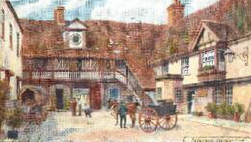
Discover Your Ancestors
Two critically acclaimed publications are available to family history researchers - the annual print magazine, Discover Your Ancestors, and the monthly online magazine, Discover Your Ancestors Periodical. Click here to subscribe.Huntingdonshire

The earliest English settlers in the district of what became Huntingdonshire were the Gyrwas, an East Anglian tribe, who early in the sixth century worked their way up the Great Ouse and the Cam as far as Huntingdon. After their conquest of East Anglia in the latter half of the ninth century, Huntingdon became an important seat of the Danes, and the Danish origin of the shire is borne out by an entry in the Anglo-Saxon Chronicle referring to Huntingdon as a military centre to which the surrounding district owed allegiance.
In about 915, Edward the Elder wrested the fen country from the Danes, repairing and fortifying Huntingdon, and a few years later the district was included in the earldom of East Anglia. Religious foundations were established at Ramsey, Huntingdon and St Neots in the tenth century, and that of Ramsey accumulated vast wealth and influence, owning 26 manors in this county alone at the time of the Domesday Survey. In 1011 Huntingdonshire was again overrun by the Danes and in 1016 was attacked by Canute.
The Norman conquest was followed by a general confiscation of estates, and only four or five thanes retained lands that they or their fathers had held in the time of Edward the Confessor. Large estates were held by the church, and the rest of the county for the most part formed outlying portions of the fiefs of William's Norman favourites. The Hundreds of Huntingdonshire were probably of very early origin, and that of Norman Cross is referred to in 963. The Domesday Survey, besides the four existing divisions of Norman Cross, Toseland, Hurstingstone and Leightonstone, which from their assessment appear to have been double hundreds, mentions an additional hundred of Kimbolton, since absorbed in Leightonstone, while Huntingdon was assessed separately at 50 hides. The boundaries of the county have scarcely changed since the time of the Domesday Survey, except that parts of the Bedfordshire parishes of Everton, Pertenhall and Keysoe and the Northamptonshire parish of Hargrave were then assessed under Huntingdonshire.
Huntingdonshire was formerly in the Diocese of Lincoln, but in 1837 was transferred to Ely. In 1291 it constituted an archdeaconry, comprising the deaneries of Huntingdon, St Ives, Yaxley and Leightonstone, and the divisions remained unchanged until the creation of the deanery of Kimbolton in 1879.
In 1174 Henry II captured and destroyed Huntingdon Castle. After signing the Great Charter John sent an army to ravage this county under William, Earl of Salisbury, and Falkes de Breauté. During the Wars of the Roses, Huntingdon was sacked by the Lancastrians. The county resisted the illegal taxation of Charles I and joined in a protest against the arrest of the five members. In 1642 it was one of the seven associated counties in which the king had no visible party. Hinchingbrooke House, however, was held for Charles by Sir Sidney Montagu, and in 1645 Huntingdon was captured and plundered by the Royalist forces.
Hunts was predominantly agricultural: the limited extent of manufacture consisted chiefly in brick making, paper making, brewing, malting, tanning, iron founding, lace making and rush work.
Exclusive census analysis from data at TheGenealogist reveals that common surnames in Hunts in the 19th century included King, Allen, Richardson, Clarke/Clark and Chapman.
Huntingdon Records Online
Leading data website TheGenealogist.co.uk has a wealth of records for Huntingdonshire (and the modern county of Cambridgeshire) that has since absorbed it. Here is a quick run-down of what you can find (in addition to national collections):
- Trade directories: two Hunts-specific directories, for 1894 and 1906.
- Census records: Huntingdonshire records for every census from 1841 to 1911.
- Parish registers: marriages from Bury, Little Raveley, Ramsey and Wistow.
- Nonconformist registers: Nonconformist chapels and meeting houses across Huntingdonshire are covered in the site’s collections.
- Land owners: the site’s huge collection of tithe commutation records includes Hunts, along with tithe maps; plus an 1873 survey of Welsh and English landowners includes the region.
- Wills: many people from Hunts can be found in Prerogative Court of Canterbury (PCC) Wills 1384-1858, and the site has a calendar of wills from the county, 1479-1652.
- Medieval visitations 1613.